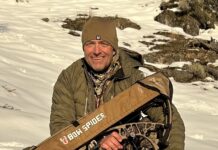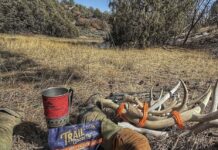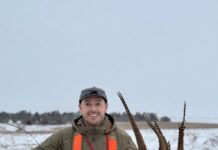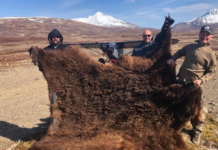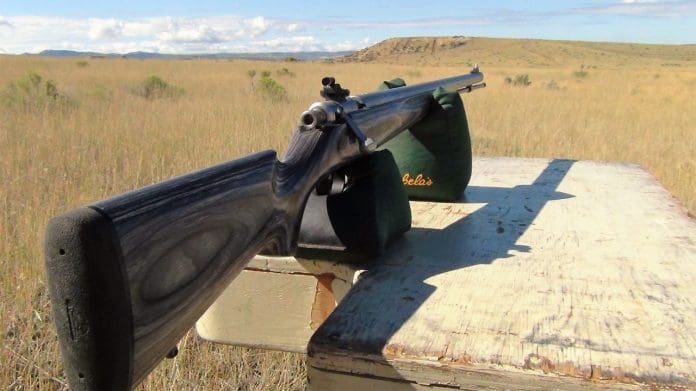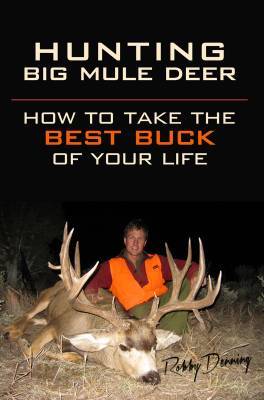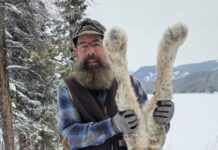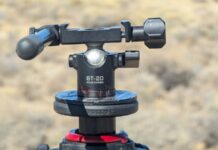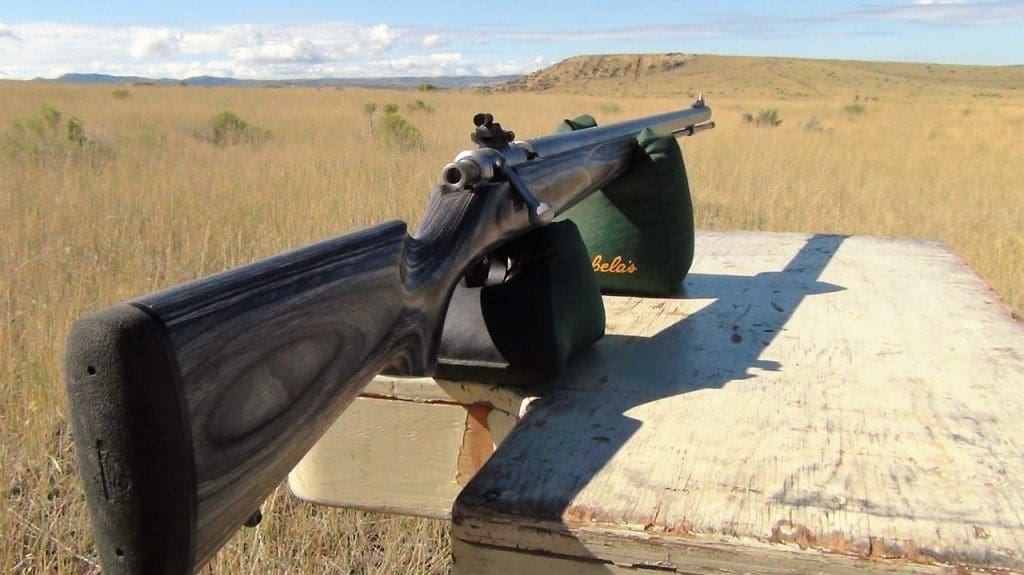
I’ve been a fan of the smokin’ single shot since my daddy left me in a tree over a bear bait as a young teenager. He wasn’t gone twenty minutes when a small bear (looked huge to me) poked his front end out from behind a Lodgepole Pine 80 yards up the hill. I buried the big front blade of that Hawken .54 behind his front leg and lit the cap. The next thing I saw was a somersaulting bear land flat on his back. The 455 grain T/C Maxiball had hit him square in the heart. While I know it was a lucky shot, my dad was as proud as a papa could be, and I was hooked on muzzleloading for life.
Western mule deer managers figured out decades ago that they could spread hunters out and sell more licenses if they offered special muzzleloading seasons. The first ones were rut hunts but soon early fall muzzleloader hunts were opened. I learned in my twenties that with scouting, September/early October can be as good as the rut for finding big mule deer if I was willing hunt with a muzzleloader. You can find these seasons in at least New Mexico, Idaho, Wyoming, Montana, Colorado, Utah, and Nevada. Throw in the fact that many of these states offer rut hunts, too, I think every big mule deer hunter needs to have the smokepole option available.
Problem is that muzzleloaders can be finicky to tune and to rely on. Add in the fact that regulations vary widely across the West, getting in to muzzleloading for big deer can be daunting to many guys.
However, I’ve had great luck with tuning many brands of muzzleloaders and I’ve never had a misfire on a big buck. I’m no expert, but if you’re new to the game, I think I can help you shorten the learning curve. I’m going to show you how I build a gun that is legal in all the Western states and can kill bucks to 200 yards (open/peep sight) and 300 yards with a scope (legal in some states). It won’t be cheap, but it’s not wildly expensive either. And if you consider the fact that your building a gun that you can use for a decade or more, the cost per year is pretty reasonable.
This project started because I not only drew one, but two muzzleloader tags this year: one for Utah and one for Nevada. One state is conservative in it’s muzzleloading rules (Nevada- open/peep sights) while the other is liberal (Utah- any power scopes). I need one gun that can do it all and do it without having to live at the gun range.
The reason I’m calling this concept “extended” range is because I’m aiming to build an accurate gun that can shoot to ranges extending beyond what the average hunter has accepted as normal for muzzleloading- about 125 yards. Beyond that, most guys find that groups explode beyond the kill zone of a mule deer and most complain that the front sight covers too much buck to even aim well. My good friend and Rokslide member Jim Carr, tackled this topic in his two-part Rokslide series here, Maximizing Muzzleloader Accuracy.
Again, I’m no expert, but I do know what has worked for me. I’ll share my favorite brands in gun and components, and my loading/shooting techniqes that produce the most reliable accuracy. I’ll be the first to admit that there are nine ways plus one to skin a coon, and there are other ways to build an extended range muzzleloader. But that is the problem that scares too many hunters away- they’re confused. I want to eliminate that.
You might have a better way, and if so, feel free to offer it up in the comments section below. But if you’re the easily-confused type who often experiences “paralysis of analysis”, then just stick to the blog. I know what I’m about to teach you works for killing big mule deer and is simple and straightforward enough that you can be hunting this fall.
First, let’s start with the gun.
I’ve owned and shot rifles built by Thompson Center (both Hawken and Encore), Khanke, Remington, and Knight. They all can be good and they all can be bad; that depends mostly on the shooter. Because regulations vary so much across the West, guys get frustrated thinking they have to have several different guns to be legal. Not true if you shop right.
I’m currently shooting a Knight Mountaineer because it’s easily changed between states requiring sabots vs. conicals, percussion cap vs. 209, granular vs. pelletized powder, and open/peep sights vs. scopes. For less than a hundred dollars to swap ignition systems, I can own one gun for the entire West (I heard once to fear the man who owns just one gun, for he probably knows how to shoot it.)
Next, let’s choose our caliber.
This one’s controversial and gets the hackles of more than a few writers up. Having killed big mule deer with both .50 and .45 caliber, I recommend .45 caliber for mule deer. Why? In building a gun to hunt any state, I need to be able to accurately shoot conicals and sabots. Most of the country allows sabots so most guns are built with a fast twist (1:30 or so) as these stabilize sabots very well. These guns can also shoot conicals, but typically the conical has to be long (which equates to heavy) to stabilize well. In many years of muzzleloading, I’ve never been able to contradict this fact and the only conicals that shoot accurately for me are heavy- in the 400-600 grain range in .50 and .54 caliber guns. This means kick and lots of it (I had to add 1 pound of buckshot to a hollow in the stock of one gun to tolerate .50 caliber, 450 grain conicals).
By choosing a .45 caliber, I can shoot conicals under 400 grains accurately and save on the kick. For example, my Colorado load features a 360 grain Precision Rifle Ultimate One Conical. Two years ago I shot a buck head-on at 100 yards and found the bullet in his back hip (more on that in my next blog). That load also shot less-than 1″ groups with very tolerable recoil. .45 caliber is also available in bullets (both sabot and conical, see prbullet.com) with high ballistic coefficients. That 360 grain Ultimate One Conical referenced above, posts a B.C. of .320 while my 240 grain Precision Rifle Dead Center sabot clocks in at .351. 10/1 update. Precision Rifle is not currently offering a full lead conical. Hope to see that change. Make sure if you call PR, let them know you’d like to see the best conical offered again.
Considering that these bullets are also lighter than accurate bullets fired from a .50 or .54 caliber, I have a flatter trajectory than the big bores, too. Here’s a video a shot a few seasons back demonstrating the trajectory of a 360 grain conical out to 250 yards
Consider Terminal Energy
I subscribe to the 1,000 ft-lbs rule for big mule deer. If I can hit them with at least that much energy, I know my odds are good of needing my skinning knife, even if the shot is marginal. With the bullets listed above, I’ve got that much energy to about 300 yards- plenty of range for big mule deer (especially considering my friend and excellent buck hunter Steve Alderman kills some really big bucks –under 10 yards- (like here,)
Cecil Epp, owner of Precision Rifle, wrote a great article on long range muzzleloading here. You’ll see we don’t exactly agree on the number, but the point is the same, energy is one of your limiting factors in extending the range of your muzzleloader.
The only thing you’re really giving up by choosing a .45 caliber is your ability to hunt elk with the same gun, as most states require at least .50 caliber for wapiti. I think if you want to kill more than a few big mule deer in your life, you don’t have the time or energy to hunt elk (or antelope, bears, cougars, etc.) so I’m not worried about recommending a .45 caliber option for the serious mule deer hunter. If you just have to hunt elk, no problem (I might someday, too), just stick with a .50 caliber and follow the rest of this series. You’ll do just fine and I’ve heard great things about Knight’s Ultra-Light muzzleloader available in .50 caliber.
In upcoming posts, I’ll cover load development, (powder, matching a bullet to the twist of your gun for the best accuracy, loading procedure, etc.) installing and shooting a mil-Dot scope, (for those guys hunting states where scopes are legal) and installing a reliable and accurate peep sight. Be sure and subscribe at the top of the page if you’d like to follow.
Read Part II here
To learn about the gear and tactics I use, check out my book, Hunting Big Mule Deer

